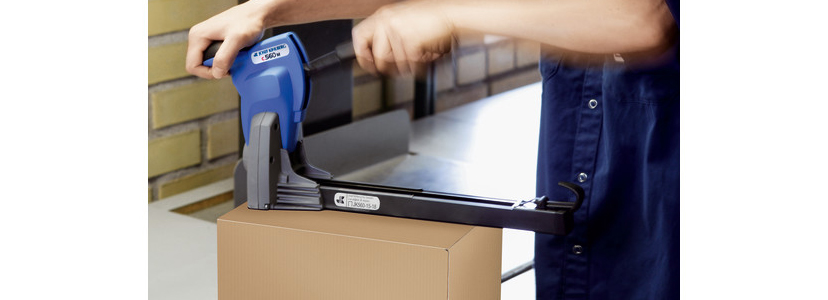How to securely seal your cardboard box

It’s all very well spending hours and hours of consideration and testing to identify the correct cardboard boxes and inner protective packaging for your product, but if you don’t seal the boxes properly as well, all that good work will of course quickly be undone.
Now, that should be relatively easy, you might think; but if it were that straightforward, why are there so many options? There a number of different kinds of packaging tape, such as polypropylene, vinyl and filament; then there’s gummed paper, staples and glue. Which should be used and when, and what are the relative advantages and disadvantages of each?
Packaging tape
Polypropylene tape, of which there is a number of varieties, is usually going to be the sealant of choice for most businesses, and for very good reasons, chief of which is that it’s going to offer the best value. However, there are a number of different varieties available with different properties. Add to that other popular options such as vinyl and reinforced filament tape, and you can see how quickly the number of available solutions add up. For a full discussion on the different kinds of packaging tape, click here.
As stated, one of the main reasons for using pressure sensitive packaging tape is its relative cheapness; it’s also very light to handle and easy to apply, and is usually readily available from a number of sources. On the other hand, unless you’re dispatching cartons in large numbers and you’re using a box sealing machine, it may not always give the neatest finish. Another disadvantage, if you’re concerned to promote your business as being environmentally responsible, is that the tape is not generally recyclable, and where it is, it’s not easy to find someone to do it. Lastly, some forms of packaging tape can degrade in long-term storage or under damp or humid conditions. This degradation can be anything from turning yellow in colour to losing its seal.
Gummed paper
There’s something almost old-fashioned about the sound of gummed (or water activated) paper tape, but if you look a little closer, you’ll see that its benefits make it ideally suited for many products in the modern marketplace. Firstly, because it works by penetrating the very fibres of the box it is being used on, it creates a very strong seal, which is also impossible to remove without leaving a very obvious mark. That combination of strength and tamper evident security makes it perfect for using on high value goods.
Gummed paper tape is also made from renewable resources and can be easily recycled along with the carton it’s sealing, which makes it a popular option with environmentally conscious businesses. Last, but not least, it can be used just as well on low quality, or previously used, corrugated board as it can on new.
One more thing: a quick glance might make you think that gummed paper costs a lot more than standard packaging tape. But plastic tape tends to come on 66-metre rolls, whereas a standard roll of gummed paper tape is 200 metres long, making it a lot more competitive than you may think.
If there is a downside, it’s that gummed paper tape isn’t always the easiest to apply; because it’s water activated, you naturally need some water handy to activate it. Dispensers tend to have a trough filled with water, which makes them difficult to move around, due to the danger of spillage. That means using it may limit where you can work.
Staples
If you’ve ever had to open a box that has been sealed with staples, you’ll know that it takes a lot more effort to open than one that has been sealed with packaging tape. If you haven’t, it’s probably worth pointing out that the staples used are a lot bigger and heavier than the ones you’ll get from your office stapler.
If you’re sealing your boxes for long-term storage or for export, than staples are a particularly good choice, because they’re not going to degrade under even the harshest climatic conditions. They’re also another good option if you want the security of a tamper evident solution.
On the downside, anyone opening a carton by hand (and, as mentioned earlier, that does take quite a bit of effort) has to take extra care to avoid puncturing the skin, which could pose a serious health risk. And that extra effort can often result in the carton being effectively destroyed and unsuitable for reuse. When you do dispose of it, it is very important this is managed carefully, as exposed staples offer the same risk to others subsequently handling the board.
Hot melt glue
Using hot melt glue sticks to seal cartons offers perhaps the most pleasing solution for the eye, making it, along with gummed paper tape, a good choice for higher value goods, where appearance is important. It’s also good for using on heavier items, as it adds a certain structural integrity to the sealed box.
Generally used in high volume dispatch environments, because it can provide for near continuous use, hot melt glue tends to be cheaper than tape as well, even though there is the extra initial cost of the gun used to heat and apply it.
The downsides to using hot melt glue are that without great care it may not fully seal every seam, leaving the contents potentially vulnerable to seepage in wet conditions. And because it requires a heat gun to melt the glue prior to application, it can also be a potential health hazard for the operator.
Rick Stanford
Latest posts by Rick Stanford (see all)
- Davpack’s Top Tips for Secure Strapping - 7th September 2022
- The Paper vs Plastic Bubble Wrap Debate - 10th August 2022
- Save Money with Royal Mail Sized Packaging - 8th July 2022
